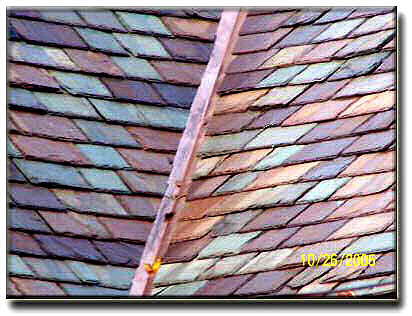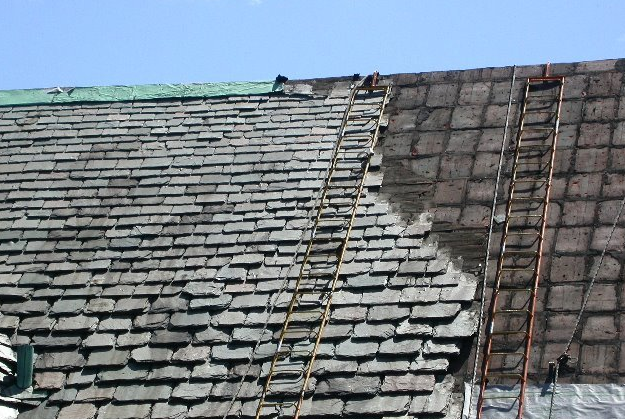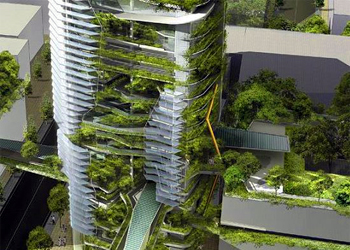The Move to LEED Webinars and Remote Working
Posted by lorne, 1st April, 2020 10:03 pm
The Move to LEED Webinars and Remote Working
It is the first of April in the year 2020 and most of our lives have been turned upside down. I write to you at a safe distance and I hope you are all healthy as we work our way through this pandemic together.
We have all made a few school and work adjustments as we all remain in quarantine. For many of us working from home is not a new concept as employers have increased the frequency of working from home, often as an effort to reduce commuting emissions. This strategy is actually part of a credit category in Location and Transportation in LEED v4 – Alternative Transportation introduced years ago. Telecommuting results in benefits such as reduced greenhouse gas emissions as a result of 2+ fewer trips taken and a more flexible schedule but also challenges such as effective productivity and collaboration on projects.
At Leadinggreen, we are lucky as myself and my employees have always worked from the comfort of their home or wherever they have an internet connection. As I am on the road teaching in 50+ cities every year, I like to say the world is my office and coffee is what we run on. Personally, the main challenge in social distancing is missing the classroom and interacting with my students. Physically seeing their brain wrap around new or misunderstood concepts and seeing the figurative light-bulb go off brings a feeling of accomplishment and satisfaction. This will be about my 9th year travelling the world to teach LEED Training workshop and exam prep courses and as the years go by, so does a need for a more sustainable personal lifestyle (pun intended). Online teaching and webinars have been on my mind for years and I have been experimenting to try and best emulate the classroom feel. In our current situation, I have had no other choice but to turn to webinars and have, so far, completed 2 successful sessions online. Others in the industry of professional development and sustainability have reached out for advice on best practices when holding live webinar presentations. After a lot of trials and tribulations with different products and software, I thought I would share my research and final results so you don’t have to!
Software
Zoom – After testing out countless options and Zoom gave me the least grief and more importantly it is the easiest for the participants to use. It was simple to email/text participants on the day of the webinar and have them join via mobile or computer. Although it is simple, Zoom does lack some customization such as enlarging the size of the presenter which I worked around by setting a separate camera app and splitting the screen to then share. I use the native Windows or Apple camera application that comes with the operating system instead of the camera embedded in Zoom which is too small. I then chose to display the Powerpoint presentation in windowed mode and divided the screen 70/30 with the Powerpoint taking 70% of the screen up. I then shared my entire screen with the participants and utilized my second monitor to display the webcams of the 20-30 participants so I could see how they react to the LEED knowledge being taught. I muted everyone’s microphones upon entering and participants used the chat question to ask questions. At the end of each LEED Credit Category, users could unmute their microphones to discuss in more detail. Below
Hardware
My laptop’s integrated microphone and webcam were suitable, but I chose to upgrade and buy an external USB webcam as well as a wireless USB microphone to ensure crisp video and sound quality. I tested out different Bluetooth microphones and other webcams and the 2 best options are available on Amazon here (not a paid ad, just my experience):
USB Camera Link Here
Wireless USB Lapel Microphone Link Here
I hope this blog post can help those save some time and research in these unprecedented and certainly trying times. I am constantly adding more webinar dates as this pandemic continues and please feel free to share some of my upcoming sessions below or stay up to date here.
– https://leadinggreen.com/webinars
Due to the ongoing impact of the Coronavirus, I will be transitioning upcoming in-person workshops to scheduled live webinars, or you can take the on-demand self-paced online workshop any time accessible for an entire year.
Webinar and Online self-paced options:
I will be offering live webinars that can be streamed on any of the following dates:
- April 7 2020 – 6:00PM – 9:30PM EDT
- April 11 2020 – 1:00PM – 4:30PM EDT
- April 18 2020 – 3:00PM – 6:30PM EDT
- April 29 2020 – 6:00PM – 9:30PM EDT
- May 9 2020 – 1:00PM – 4:30PM EDT – OR –
- May 15 2020 – 2:00PM – 5:30PM EDT
The above options are identical to the in-person workshops.
You can register here for a webinar – https://leadinggreen.com/webinars
Online – Start today – Self-paced recorded workshop
Or take the on-demand recorded course completed at your own pace here – https://leadinggreen.com/online
COVID19 and Prometric Testing centers
I have also received a lot of questions about the current testing status. Currently, most Prometric centers are closed and have different expected times or reopening which can obviously change. Keep updated here – https://www.prometric.com/closures
I am in constant talks with the USGBC to try and find alternative ways for students to take the exam such as proctored online and will keep you informed. If needed, I will be extending access to my materials.
I wish you all the best in these trying times and have an open phone line or email at all times. I am here to help in any way whether it is LEED related or general life-related.
Lorne Mlotek BASc., LEED AP BD+C, O+M
President, LeadingGreen
USGBC Faculty
416-824-2677
416-824-2677
Turning 26 and the Need for a Refreshed Green Vibe
Posted by dev, 20th June, 2017 2:22 am
My 26th year on the planet Earth is coming and going as we rotate the sun one more time. This will be my 8th year at the helm of LeadingGreen and the 4th year since graduation. In my life change comes in fours, nearly every 4 years of my existence I have experience drastic change, whether that be from middle school to high school, high school to University, University to the so-called “real-world” and now we’re here. At the end of this four year term I find myself at the crux of what I feel should be an important step or accomplishment in my life. I feel waiting for an epiphany moment of realization to arrive on my face like a cool ocean breeze of satisfaction and recharge to take on the next four year term.
Alas, this is not how life works. No longer are there any societal expectations that I need to conform to, no goals I have deadlines to meet, only that of my own. As I travel around as a wandering instructor and try to spread the purely logical word of sustainability to the 10000th student of mine, I don’t feel as fulfilled as I should. For 8 years I have tried and exceeded my attempt to make sustainability education accessible and available for all those regardless of background and monetary situation, I have begun developing student housing in markets in need of revitalization and assisted students and professionals in finding suitable placements through greenrecruiting.com. So what next? What now forlorn for Lorne in the next 4 year chapter of trying to make a difference?
I was under the impression that public policy was the logical end goal to change through grassroots initiative with the hope of holding a position in governance. But, I as many of you have seen that in our communities public works is the slowest answer to change and must be market driven and beneficial to the public, private, economic and environmental sectors. We will see that exiting COP21 will not have the dire effects on American emissions as the market demands environmentally conscience, design, construction and operations. Thankfully, my passion for buildings falls in the easiest way to reduce our emissions as it is 100 times less expensive to reduce our consumption of 1 kWh than it is to produce 1 kWh whether it be through Nuclear, Coal or Renewables. Buildings still being the largest consumer and our urban centers taking more and more of the population burden, there is only more demand in this sector for reducing our consumption and that is what I will continue to do.
At 26, at the self-imposed pivotal end to another 4 year chapter I realize it is not that at all. It is not a time in need of drastic directional change, it is a time to slow down and reflect when I need to, speed up and take on more than I can juggle when those challenges arise and a time to stop looking at like set, divided timeline of finish lines. This is my 26th year rotating around the sun, but you can be sure the humans will continue to follow that elliptical path long after I am gone and Earth long after humans have run our course. So, in the next 4 years, I will continue to do what makes me happy on a daily, monthly and annual basis; make sure the Earth is better off when I leave it than when I was born onto it by meeting and teaching/learning from thousands and thousands more people across the globe. I will ignore the noise of those trying to capitalize on the buzzword of our generation for purely monetary gain but rather embrace them and Shepherd them into doing the right thing even if for the wrong reason, because it is the easier for them to do. Breathe easy as our time is short but impact can be great whether silent or loud.
Sincerely,
Lorne
Our embedded nature
Posted by lorne, 19th June, 2014 3:52 am

Another year gone by, exactly 1 year since my convocation and another annual birthday blog post. This year is my 23rd one on the planet and my 5th one involved in trying to make it a little greener. A year ago I had just returned from travelling overseas and was profoundly influenced by how far ahead many parts of the world were compared to all that I had known. A year ago I had a funny little idea to become a rock star of sustainability, frolicking across the continent spreading the financial and environmental merits of consciously designing and constructing the built-environment. I couldn’t see myself just helping already converted building owners achieve their green goals, but rather attempt to enlighten others and empower them with tools to progress North American building practices. My goal for humanity has always been progress and I am satisfied if I can play a tiny role in pushing our lifestyle in the ‘right’ direction, to prosper in a sustainable future.
In this past year I have held green building training classes in over 60 unique cities to over 1000 students and professionals. From sustainably minded Burlington, Vermont to the vineyards of Virginia and driving down the coast of California; I met countless personalities who expressed perspectives that I never knew exist. I encountered individuals who would only eat organic foods, whilst fighting tooth and nail for their right to bear arms, others who only saw the green industry as a way to make profit and extremists on all ends of the spectrum. The one idea that stuck with me was our embedded nature in their idea of what is right and wrong and the challenge of shifting that embedded nature. At one point this year I even turned to politics to see how lobbying groups and grass roots movements affect our political parties but this realm is engulfed in stubborn people unwilling to listen. This is the issue that is plaguing our society from the top of our pyramid to the bottom – our inability to change and see the light at the end of that tunnel. However, as I continued my travels I began to see that each person had a kryptonite, whether it be financial possibilities, risks to future generations or just trying to better ones self.
My vision has taken a shift for my 23rd year to one that sees the necessity of driving change and breaking the public’s embedded nature to see that dim or bright green light. The new version of LEED is helping me do exactly that as it is a bright green light which is driving change in numerous industries. In the past I have used this annual post to point out the flaws in LEED such as its large “non-profit” budget and dare I say Greenwashing. As I continue to study LEED V4 and learn about America’s backlash against it, I can see how it is driving markets, industries, companies and even individuals to change their embedded nature reluctantly for the better. Too many of our minds are engrained in the idea that if we kick the can down enough generations, someone will figure out how to reverse climate change. This end of pipe approach is a highly risky one as we simply do not know when that road will wash out and the Earth’s systems simply cannot recover from our damage. Even I do not think that this will be in my lifetime, but right there is an example of a mindset in need of discarding.
By this time next year I hope to be reflecting on my teachings not only on this continent but also in other parts of the world including Saudi Arabia, Honduras, Mexico and Dubai lined up for the coming months. I hope my knowledge does not only translate into LEED professional designations which allow people to tout their sustainable knowledge but also alter their outlook and day-to-day life. As the public gradually realizes Earth’s mortality we will begin to drive change across all nations, governments, communities and individuals.
Advantages of green slate roofing
Posted by lorne, 13th August, 2013 6:32 pm
One of the best way in which you can make your green building in an environmentally sustainable way is by opting for green slate roofing services. Since the roof of your house gets exposed to cold,sunlight and heat, you can improve the energy efficiency level of your home.This is preciously why homeowners in different parts of the globe are relying on high-quality green slating roofing services and using them to remodel their homes.

Why slate roofing?
If you wish to go for green building, then slate roofing is the most suitable solution for your home. Roofing companies used hundred percent natural materials for building slate roofs and given the fact that these material require very little amount of processing to convert it into a proper and effective roofing system. Green slate roofing has become an ideal choice for many homeowners. Green slate roofing is highly durable and requires little maintenance, which is yet another reason why homeowners are flocking for this particular roofing system.

How to increase energy efficiency using green slate roofing solutions?
If you choose green slate roofing system you will make more energy savings as compared to normal roofing system.As far as energy saving is concerned, you can extract the maximum from your green slate roofs by following some of the points listed here:

Rainwater storage system installation:
If you install drums and cisterns while getting your green slate roofing system constructed, you will cut down your bills pertaining to water consumption to a significant extent. You can in turn use this water for the purpose of landscaping.
Radiant heat barrier system installation:
In order to minimize the transfer of radiant heat to the attic of your green building, it is advisable that you get radiant heat barrier system installed. This is basically made of a tin foil and is backed by a mylar sheet of a paper. This will reduce the transfer of radiant heat by around ninety five percent only if you install it towards the underside of the roof.

Environmental advantages of green slate roofing:
You can consider using reclaimed slates, which is basically a natural stone in order to build your green slate roofing system. Consult your roofing contractor and find out if he/she can work with reclaimed slate as it is extremely eco-friendly. Also, at the time of replacing your existing slate roof ,you can send it for recycling instead of dumping it in the landfill or elsewhere.Yet another environmental benefit of green slate roofing is that they last really long. If installed appropriately it can last for around hundred years with only a little amount of maintenance and repair.
In a nutshell, green roofing is all about green building which is energy efficient, high quality, safe and healthy. In order to install them effectively, your contractor won’t require anything beyond high quality natural slate and few nails. Green slate roofing will lead to LEED credits by increasing a building’s energy efficiency and reducing the heat island effect. It is better that you hire an expert roofing contractor who has the requisite skill and expertise to repair and install slate roofs as even a slight mistake can result in leakage, damage from moisture and give rise to mold inside your house, thereby affecting the air quality and posing health related problems.
Vertical Farming
Posted by lorne, 29th July, 2013 7:26 pm

Building for the future is all about sustainability. Living habitats that blend nature with technology to make the best use of space in a way that is beneficial to all life on Earth. The way we go about doing that is by following the three E’s. Environment, Economy, and Energy. There are many solutions, but none handle all three quite like vertical farming.
About Vertical Farming
Vertical farming is not a new idea, just a technique that was long forgotten. The phrase was first coined in Gilbert Bailey’s 1915 book titled “Vertical Farming.” In the book he describes how farmers could go down into the Earth to maximize their farming area, opposed to expanding outwards. This was to address the issue of running out of space due to increasing populations. Today’s version is the same concept, only instead of going down you go up.
Answering the Three E’s (or the triple bottom line)
Vertical farm buildings answers a wide variety of problems that farmers deal with on a daily basis including pests, disease, irrigation, cost, and weather. Not only does it lower cost and make food more available to everyone, but it helps us save space for wildlife.

Energy: Plants such as corn, which are used to make bio-fuels could be grown in every town, diminishing our dependency on oil. The fruit of these plants gives us food, while the waste is turned into usable energy.
Economy: Bringing the food source closer to where people live lowers costs, and lets people have more spending money, thus more businesses have customers.
Environment: The home of millions of animals and other creatures benefit from this space saver. Also a little green in the city would also help filter toxins out of the air. And of course with all those trucks hauling our grocery goods off the road, we can all breathe much easier.
Types of Vertical Farming:
There are many ways vertical farms can be made, from small home gardens to industrial sized farming. Just search the web for “Vertical Farming Systems,” and you will find many companies selling vertical garden kits for your yard and your house. Ed Harwood’s “AeroFarm” aeroponic system is a great example. Additionally there are kits to grow plants along the exterior walls of your home or any other building. These mini vertical farms are great for growing herbs and vegetables used in cooking. aerofarm:

Another form of vertical farming, which has just begun to be implemented is skyscraper farms. Potentially an 18 story tower could feed about 50,000 people, and take up much less land. Think of it as a giant green house. Add in an automated irrigation, fertilizing, and lighting system powered by wind and sunlight, and you have got a reliably self sustaining source of food and energy.

Could you imagine getting your fruits and veggies from down the street, instead of trucked for days across country. Now that is fresh. Good bye high gas prices, and hello vacation with family. More jobs are created, and gas guzzling heavy farm equipment sits in museums as reminders of our filthy past. The air you breathe is cleaner, the food you eat is safer, and your overall way of life is improved thanks to green building like the vertical farms right in your neighborhood.











